(Click on photographs to see a larger version. Note: Some file sizes are quite large; not recommended for people using a dial-up connection.)
Here is a map of where we went. The numbers correspond to the days in the trip report.
Day 7, Sunday 17 August, Tennant Creek, Daly Waters, Katherine, Darwin
After an early breakfast, we were given a brief tour of Tennant Creek, including the information centre just outside town. The private tourism centre there had a working mine and one of only three working stampers in the Territory. They do demonstrations of how gold mining was done, from the mine all the way through the process, but we were there too early to see it. Worth a return visit I would think.
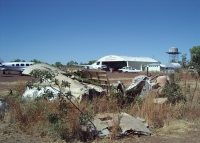 Flew to Daly Waters, landing at the field Qantas used prior to WWII when it became a military airfield. The old galvanised iron hanger survives in this dry climate. It was constructed initially about 1930 for the Daly Waters Airmail run. It later became a major staging point for interstate and international airlines. It was declared an RAAF station on 18 March 1942. There is the start of a small museum at the airstrip, telling the history and decline of the strip. They hope to preserve the old hanger, one of the oldest in the Territory.
Flew to Daly Waters, landing at the field Qantas used prior to WWII when it became a military airfield. The old galvanised iron hanger survives in this dry climate. It was constructed initially about 1930 for the Daly Waters Airmail run. It later became a major staging point for interstate and international airlines. It was declared an RAAF station on 18 March 1942. There is the start of a small museum at the airstrip, telling the history and decline of the strip. They hope to preserve the old hanger, one of the oldest in the Territory.
Daly Waters township comprises a few houses and the famous Daly Waters Hotel. The Overland Telegraph Line reached Daly Waters in June 1872 and for a short time (until the line was completed) a ‘pony express’ was established to cover the 421 km gap between Daly Waters and Tennant Creek. The telegraph line was finally completed on 22 August, 1872.
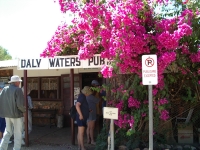 As early as 1893 a hotel was built in the town. It is now one of the oldest buildings in the Northern Territory. The reason for the construction of the hotel was that Daly Waters was becoming an important stopover point for people travelling from the north to the south as well as for the drovers moving cattle across from the Kimberleys to Queensland.
As early as 1893 a hotel was built in the town. It is now one of the oldest buildings in the Northern Territory. The reason for the construction of the hotel was that Daly Waters was becoming an important stopover point for people travelling from the north to the south as well as for the drovers moving cattle across from the Kimberleys to Queensland.
We had a great picnic lunch at the pub. That is a place with real character, but very difficult to photograph. They now have four self contained motel units, and another bunch with shared facilities. We’d come briefly to town last year in our motorhome, but hadn’t stayed long enough to really appreciate the pub. http://walkabout.com.au/locations/NTDalyWaters.shtml
Next we flew over Katherine Gorge (Nitmiluk), which we had visited last year, landing at the Katherine airport (also an Air Force base) to refuel. The terminal building was small, with many military hangers in the distance away from the civilian side.
Soon we were back in the air for the long slow climb to our 8,000 feet cruising altitude. Katherine was 30C, even in mid winter, and the engine works less efficiently. Lower lift in the hot air restricted us to about 500 feet per minute climb, against maybe three times that when taking off from Sydney.
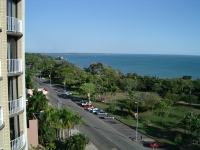 We flew over Litchfield National Park, arriving in Darwin mid afternoon for a free afternoon and evening. Not much is open in Darwin on a late Sunday afternoon. The coach stopped at a liquor store on the way to the hotel, and people piled out in search of something to drink for the following evening, in surroundings that would lack a bar. It was like a herd of locusts, however a significant number of the purchases were of drinking water.
We flew over Litchfield National Park, arriving in Darwin mid afternoon for a free afternoon and evening. Not much is open in Darwin on a late Sunday afternoon. The coach stopped at a liquor store on the way to the hotel, and people piled out in search of something to drink for the following evening, in surroundings that would lack a bar. It was like a herd of locusts, however a significant number of the purchases were of drinking water.
We stayed overnight at the Holiday Inn Darwin, 122 The Esplanade, Darwin NT 0800 phone (08) 8981 5388. It had some great views over water from our 8th floor room.
Day 8, Monday 18 August, Cobourg Peninsula
Up at 5:15, breakfast at 6:00, in the air by 8:00. Groan. Flew by Tiwi Islands (100km north of Darwin) and Van Diemen Gulf northeast to the Cobourg Peninsula in Arnhem Land. Landed at Smith Point, at the far northern end where the Cobourg Peninsula meets the Arafura Sea.
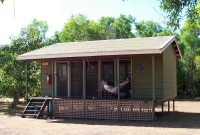 We stayed at “The Huts” overlooking the entrance to Port Essington, only metres from the sandy beach. Complete with solar power, gas stove, fridge and kitchen utensils, the huts provide rustic accommodation with separate bush shower and compost toilet. We had to use these dormitary style, as four huts were all there was. Cobourg Beach Huts, PO Box 38610, Winnellie NT 0812 phone (08) 8979 0455. http://www.nt.gov.au/nreta/parks/find/gariggunak.html
We stayed at “The Huts” overlooking the entrance to Port Essington, only metres from the sandy beach. Complete with solar power, gas stove, fridge and kitchen utensils, the huts provide rustic accommodation with separate bush shower and compost toilet. We had to use these dormitary style, as four huts were all there was. Cobourg Beach Huts, PO Box 38610, Winnellie NT 0812 phone (08) 8979 0455. http://www.nt.gov.au/nreta/parks/find/gariggunak.html
Garig Gunak Barlu National Park is pronounced Gah-rig Goon-uk Bar-loo, which means Garig (a local language name), Gunak (land), Barlu (deep water). The park occupies 2,207 square kilometres, including the Cobourg Peninsula, the surrounding waters of the Arafura Sea and Van Diemen Gulf, and some of the neighbouring islands.
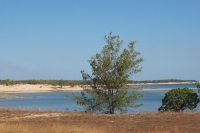 Cobourg Peninsula is Aboriginal land. The cultural centre explores the history of the area, which lies within the clan estates of the Iwaidja speaking peoples of western Arnhem land. Custodianship is shared between five Aboriginal clan groups, the Agalda, Ngaindjagar, Madjunbalmi, Minaga and Muran.
Cobourg Peninsula is Aboriginal land. The cultural centre explores the history of the area, which lies within the clan estates of the Iwaidja speaking peoples of western Arnhem land. Custodianship is shared between five Aboriginal clan groups, the Agalda, Ngaindjagar, Madjunbalmi, Minaga and Muran.
The Park is managed jointly the traditional land owners and the Parks and Wildlife Commission of the Northern Territory. It contains aspects of particular historical, archaeological and biological importance.
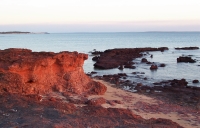 Some of the species in the area include the rare Dugong and five marine turtles, the Loggerhead, Hawksbill, Olive Ridley, Leatherback and Flatback Turtles. The park is also home to the largest wild herd of Banteng, Indonesian cattle that are now endangered in their native habitat. It is also a birds watcher’s paradise.
Some of the species in the area include the rare Dugong and five marine turtles, the Loggerhead, Hawksbill, Olive Ridley, Leatherback and Flatback Turtles. The park is also home to the largest wild herd of Banteng, Indonesian cattle that are now endangered in their native habitat. It is also a birds watcher’s paradise.
The British made two attempts at settling this remote area – Fort Wellington [1827] and the Victoria Settlement [1838], as a bastion against Dutch and French expansion in the East Indies. Both settlements failed. Hopes that Victoria Settlementt might become the next Singapore were soon doomed, not least by water shortages, a cyclone in the first year, and malaria that took 60 lives. It lasted from 1838 to 1849, manned by 100 soldiers in full uniform, despite the tropical heat. The wooden structures are all gone, but traces of the thousands of rocks at the jetty still remain. It can be reached only by water.
We divided into two groups. Our group visited the Ranger and National Parks display. Then we had a walking tour through the park for a few more hours and a great picnic lunch back outside the huts. http://www.savannah-guides.com.au/page2-11.html
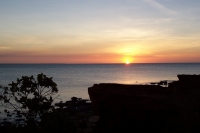 The other group had left the beach on a boat to visit Victoria Settlement, but with the tide going down, were scheduled to return to a boat ramp. We drove there, but saw no sign of the boat, and we couldn’t get to them on the radio. We eventually concluded that the boat must have been caught by the tide. We returned to the huts and relaxed for the afternoon. The group eventually returned after 5 pm, having been stranded on shore, unable to get the boat afloat until the tide came in. They’d had plenty of water, but no lunch. As it was now far too late to take our group to Victoria Settlement, the boat instead took us off for a sunset cruise.
The other group had left the beach on a boat to visit Victoria Settlement, but with the tide going down, were scheduled to return to a boat ramp. We drove there, but saw no sign of the boat, and we couldn’t get to them on the radio. We eventually concluded that the boat must have been caught by the tide. We returned to the huts and relaxed for the afternoon. The group eventually returned after 5 pm, having been stranded on shore, unable to get the boat afloat until the tide came in. They’d had plenty of water, but no lunch. As it was now far too late to take our group to Victoria Settlement, the boat instead took us off for a sunset cruise.
We had a late evening barbeque near the shore, featuring good food and a great sunset. The mosquitos weren’t nearly as bad as expected; hardly any at all. The night was good for stargazing — a fine excuse for getting up to go to the outdoor facilities. This is indeed a magic spot.
Day 9, Tuesday 19 August, Mount Borradaile
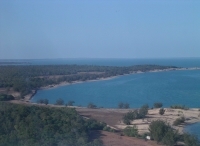 Up around 6, for breakfast and an early scenic flight SE over islands of Cobourg Marine Park in Van Dieman Gulf. We diverted to check out how much of Victoria Settlement could be seen from the air – the ruins of one building.
Up around 6, for breakfast and an early scenic flight SE over islands of Cobourg Marine Park in Van Dieman Gulf. We diverted to check out how much of Victoria Settlement could be seen from the air – the ruins of one building.
Landed at Mt Borradaile in stony western Arnhem Land, the largest Aboriginal reserve in Australia, which covers approximately 94,000 square kilometres.
Access is normally by twin-engine plane from Darwin or Kakadu. Visitor numbers are strictly limited and by permit only, arranged prior to arrival with the Aboriginal custodians. Booking well in advance is essential. The operation is run by Max and Philippa Davidson. Mt Borradaile is claimed to be "one of the most powerful cultural sites in Australia". The custodians have entrusted Max to share some of the treasures. http://www.savannah-guides.com.au/page3-16.html
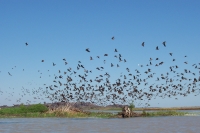 Mt. Borradaile and the surrounding sandstone hills are honeycombed with caves, once occupied by Aborigines, as far back as more than 40,000 years ago. Thousands of rock paintings chronicle the spiritual element and substance of everyday life.
Mt. Borradaile and the surrounding sandstone hills are honeycombed with caves, once occupied by Aborigines, as far back as more than 40,000 years ago. Thousands of rock paintings chronicle the spiritual element and substance of everyday life.
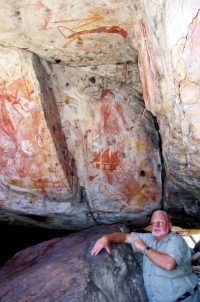 Max has developed his knowledge of the area’s fascinating culture, wildlife and bush not only through a close association with the local traditional owners, but also from the pioneering buffalo hunters, musterers and croc catchers of the past who have all played a significant part in the history of the area.
Max has developed his knowledge of the area’s fascinating culture, wildlife and bush not only through a close association with the local traditional owners, but also from the pioneering buffalo hunters, musterers and croc catchers of the past who have all played a significant part in the history of the area.
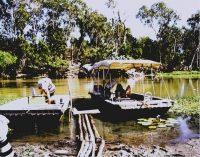 Mount Borradaile Safaris commenced operations in 1986 after the Davidson family successfully negotiated an exclusive lease to 700 square kilometres of pristine wilderness in north-west Arnhemland with the traditional Aboriginal land-owners of the area. Experienced guides will escort visitors through a series of educative adventures that may include visiting the over 40,000 year old Aboriginal rock art and occupation sites, and receiving an interpretation of those sites. Over 200 species of birds. http://www.arnhemland-safaris.com/
Mount Borradaile Safaris commenced operations in 1986 after the Davidson family successfully negotiated an exclusive lease to 700 square kilometres of pristine wilderness in north-west Arnhemland with the traditional Aboriginal land-owners of the area. Experienced guides will escort visitors through a series of educative adventures that may include visiting the over 40,000 year old Aboriginal rock art and occupation sites, and receiving an interpretation of those sites. Over 200 species of birds. http://www.arnhemland-safaris.com/
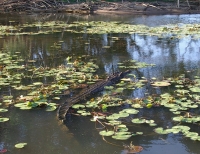 Two vehicles took us on a bumpy ride across the dried-out wetlands (heavily dug up by pigs) to the edge of the water where we boarded two boats for a cruise to one of the many rock art sites. On the cruise we saw an amazing number of birds, including huge flocks of some varieties, several saltwater crocodiles, and a large goanna.
Two vehicles took us on a bumpy ride across the dried-out wetlands (heavily dug up by pigs) to the edge of the water where we boarded two boats for a cruise to one of the many rock art sites. On the cruise we saw an amazing number of birds, including huge flocks of some varieties, several saltwater crocodiles, and a large goanna.
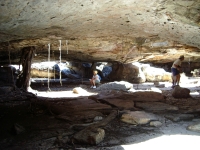 The rock paintings were in extensive rock shelters showing ancient occupation. Charlie, one of our guides, asked that we not photograph the ochre painted skulls and other human bones in the burial area of the site. The bones that were high on a shelf were in very good condition, however those that had fallen to the cave floor were in poorer shape. The names of the deceased were not spoken after death, but were referred to in terms like The Boy Who Drowned in the River. The bodies were returned to their home territory, where an elaborate Sorry ceremony was held. The body was put on a wooden platform, and covered. After about two years the bones were collected and cleaned using sand. The bones were then placed in the cave burial area, after the spirit of the dead one had departed. The bones themselves were no longer of any spiritual significance.
The rock paintings were in extensive rock shelters showing ancient occupation. Charlie, one of our guides, asked that we not photograph the ochre painted skulls and other human bones in the burial area of the site. The bones that were high on a shelf were in very good condition, however those that had fallen to the cave floor were in poorer shape. The names of the deceased were not spoken after death, but were referred to in terms like The Boy Who Drowned in the River. The bodies were returned to their home territory, where an elaborate Sorry ceremony was held. The body was put on a wooden platform, and covered. After about two years the bones were collected and cleaned using sand. The bones were then placed in the cave burial area, after the spirit of the dead one had departed. The bones themselves were no longer of any spiritual significance.
 In the late afternoon, most of the group took a twilight guided boat tour on Cooper Billabong to view birdlife in great variety. Glass of wine and biscuits with cheese and pate as the sun sinks. We sighted enormous flocks of whistling ducks, water walking Jesus birds, pelicans of course, and even Jabiru and sea eagles. I need hardly mention we saw crocodiles, mostly salties (esturine) but a few lively freshies as well.
In the late afternoon, most of the group took a twilight guided boat tour on Cooper Billabong to view birdlife in great variety. Glass of wine and biscuits with cheese and pate as the sun sinks. We sighted enormous flocks of whistling ducks, water walking Jesus birds, pelicans of course, and even Jabiru and sea eagles. I need hardly mention we saw crocodiles, mostly salties (esturine) but a few lively freshies as well.
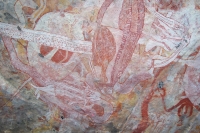 Comfortable safari tents with beds at Mt Borradaile. Davidson’s Arnhemland Safaris PL, PO Box 41905, Casuarina NT 0811 phone (08) 8927 5240.
Comfortable safari tents with beds at Mt Borradaile. Davidson’s Arnhemland Safaris PL, PO Box 41905, Casuarina NT 0811 phone (08) 8927 5240.
Page last updated 5 October 2007.
